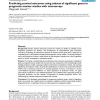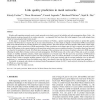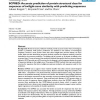BMCBI
2006
13 years 4 months ago
2006
Background: We describe Distill, a suite of servers for the prediction of protein structural features: secondary structure; relative solvent accessibility; contact density; backbo...
BMCBI
2006
13 years 4 months ago
2006
Background: Understanding gene regulatory networks has become one of the central research problems in bioinformatics. More than thirty algorithms have been proposed to identify DN...
BMCBI
2006
13 years 4 months ago
2006
Background: Diverse modeling approaches viz. neural networks and multiple regression have been followed to date for disease prediction in plant populations. However, due to their ...
BMCBI
2006
13 years 4 months ago
2006
Background: Prediction of human cell response to anti-cancer drugs (compounds) from microarray data is a challenging problem, due to the noise properties of microarrays as well as...
BMCBI
2006
2006
A Regression-based K nearest neighbor algorithm for gene function prediction from heterogeneous data
13 years 4 months ago
Background: As a variety of functional genomic and proteomic techniques become available, there is an increasing need for functional analysis methodologies that integrate heteroge...
BMCBI
2006
13 years 4 months ago
2006
Background: In recent years protein structure prediction methods using local structure information have shown promising improvements. The quality of new fold predictions has risen...
BMCBI
2006
13 years 4 months ago
2006
Background: Genetic markers hold great promise for refining our ability to establish precise prognostic prediction for diseases. The development of comprehensive gene expression m...
COMCOM
2008
13 years 4 months ago
2008
Wireless self-organizing networks such as mesh networks strive hard to get rid of mobility and radio propagation effects. Links
BMCBI
2008
13 years 4 months ago
2008
Background: Prediction of protein solvent accessibility, also called accessible surface area (ASA) prediction, is an important step for tertiary structure prediction directly from...
BMCBI
2008
13 years 4 months ago
2008
Background: Protein structure prediction methods provide accurate results when a homologous protein is predicted, while poorer predictions are obtained in the absence of homologou...




